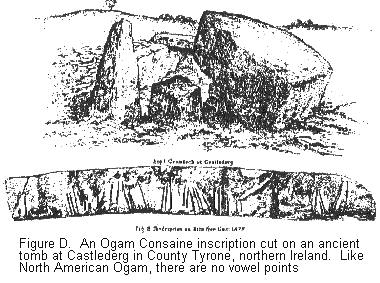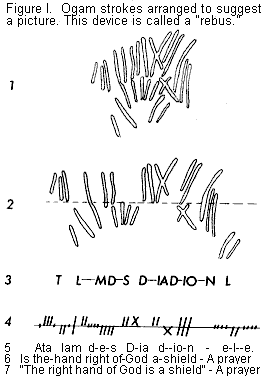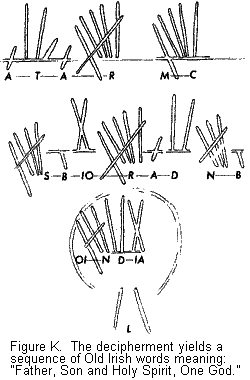The Council for West Virginia
Archaeology reproduces these original ogham (ogam) petroglyph articles for the
record only. We give absolutely no credence to their conclusions.
For articles discussing these claims, see the listing at the end of this page.
Part 3
CHRISTIAN MESSAGES IN OLD IRISH SCRIPT DECIPHERED FROM ROCK CARVINGS IN W.
VA.
By Barry Fell
© 1983 WV Division of Natural Resources, used with permission
Editor's Note [Wonderful West Virginia's editor]:
In the following article, America's leading expert on ancient languages details his decipherments of two southern West Virginia petroglyphs, one in Wyoming County, the other in Boone County. Because of the innovative and controversial nature of this material, we have chosen to publish Barry Fell's step-by-step description of his decipherment process, in full, for credibility and so that readers may understand how these translations were made.
The decipherment process is complex and technical in nature, therefore, it is impossible to present it in on easy-to-read style. Readers willing to expend the time and mental energy required to study the material will be astounded and intrigued, as the author takes them through the systematic process which led to his startling translations of mysterious writings etched centuries ago by an unknown person on West Virginia s ancient rock cliffs.
Additional archaeological evidence in the same vein as that presented here has been discovered recently in West Virginia, which seems to further substantiate Fell's decipherments. It is currently being analyzed. When studies are complete, details of these additional findings will appear in future issues of this magazine.
The rock-cut inscriptions which are the subject of this article are located at archaeological sites in Wyoming and Boone Counties, West Virginia. They appear to date from the 6th—8th centuries A.D., and they are written in Old Irish language, employing an alphabet called Ogam, found also on ancient rock-cut inscriptions in Ireland. The inscriptions are accompanied by short annotations in ancient Libyan alphabetic script. The Libyan script is used to render two languages in the annotations (1) the ancient Libyan tongue itself, and (2) an Algonquian dialect of the northeastern group, perhaps allied to Shawnee. In this first report I deal only with the Old Irish texts, as these are the most detailed.
The Ogam alphabet is illustrated in Figure A.
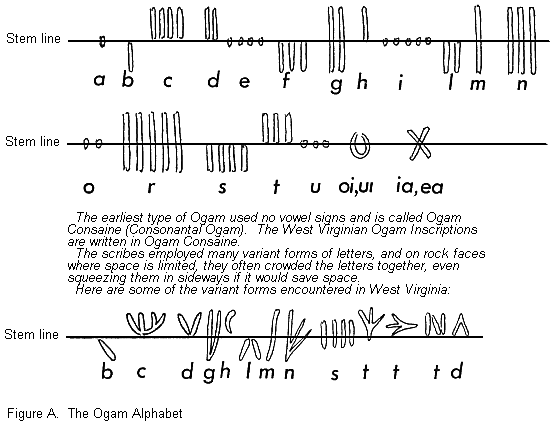
Most of our knowledge of Ogam comes from a Dublin manuscript, known as the Ogam Tract, composed by an unidentified monk in the 14th century. It describes some 94 varieties of Ogam and other alphabets known to the scribe, but the writer indicates that he knew of some 150 varieties of ancient Irish alphabets. A portion of one of the folio charts in the Ogam Tract is shown in Figure B.

Archaeological research shows that Ogam was widely used in many parts of the ancient world. It also occurs on Celtic coins issued in Gaul in the second century before Christ, some hundreds of years before the earliest known Irish Ogam inscriptions.
The scribe relates the mythical account of the origin of Ogam. He tells us that the first Ogam message ever written was the work of a magician named Ogmios, and that it was a warning sent to Lug informing him of a plot to abduct his wife. On line 11 of folio page 309 of the Ogam Tract, the scribe reproduces the supposed warning message sent to Lug. It consists of the Ogam letters "S—N." This is the earliest literary reference to the Ogam Consaine (Consonantal Ogam), for the letters "S-N" are the consonants of the Old Irish word "siona" meaning "warning." The passage in the Tract (Figure C) is marked by the arrow and the word is shown enlarged below the Tract.
Although the scribe evidently was familiar with Ogam Consaine, he did not give it that name, or any name at all. It was left for the 18th century Irish poet Eoghan Ruadh Ua Suilleabhain (1748—84) to coin the name, "Consonantal Ogam," and he did so in drawing attention to old, undeciphered, rock-cut inscriptions in Ireland, whose meaning remained a mystery (Figure D); for scholars of the day, unable to deal with a written script from which the vowels were omitted, could make no sense of the markings.
The ancient Ogam Consaine inscriptions of Ireland are found mainly in that country's northern section, and there are others of similar type in parts of Scotland. An example is the line of Ogam slashes visible on the capstone of the Bronze Age cromlech (grave monument) at Castlederg, in County Tyrone. In southern Ireland, especially Counties Cork and Kerry, the Ogam inscriptions are fully provided with the vowel points, and these have therefore been deciphered long since. The West Virginian Ogam inscriptions seem to have an affinity with those of northern Ireland.
Irish monastic records state that during the reign of Pope Pelagius (555—561), an Irish ecclesiastic named St. Brendan (Brennain) made two voyages across the Atlantic Ocean, discovering a land far to the west, identified by some historians as North America. It is known that Brendan founded the famous monastery of Clonfert in County Galway in the year 561, by which date his last voyage had been completed. It seems possible that the scribes who cut the West Virginia inscriptions may have been Irish missionaries in the wake of Brendan's voyage, for these inscriptions are Christian. This is evident even before they are deciphered, because the early Christian symbols of piety, such as the various Chi-Rho monograms (of the name of Christ) and the Dextera Dei ("Right hand of God"), appear at the sites together with the Ogam texts.
Examples are shown in Figure E, together with corresponding examples from Europe. The Chi-Rho comprises a symbol formed from the two Greek letters that stand first in the name "Christ," Ch (resembling an X) and R (resembling a P). These letters are written separately at the site in Boone County, which is called the Horse Creek Petroglyph. At the Wyoming County Petroglyph, one of the Chi-Rho signs is that shown in Figure E-5. This is a combination of the two letters and closely matches a version used on the Byzantine coins of the Emperor Justinian 1(527—565), shown in Figure E-4. A different version of the Chi-Rho is the labarum (scepter) type, so-called because it formed the upper part of the labarum scepter of the Byzantine emperors. Figure E-1 shows the labarum Chi-Rho that appears on coins of Gratian (367—375), and Figure E-3 is the matching version at the Wyoming County site, while Figure E-2 is a late version found on coins issued by the Anglo-Saxon Wulfred, Archbishop of Canterbury (805—833).
Peculiarly Irish is the symbol called by scholars "The Incarnation Initial," of which a simplified version is shown in Figure E-7, taken from the Lindisfarne Gospels (A.D. 700). It consists of a large Chi, always introduced by the scribes at the beginning of the 18th verse of the first chapter of Matthew where the evangelist writes, "Now the birth of Jesus Christ was on this wise."
The Wyoming County inscription relates the birth of Christ, and then, after stating
that the child was born to Mary, the scribe inserts an Ogam version of the Incarnation
initial, shown in Figure E-8. He has inserted some Ogam strokes into the Chi,
to make the word "G-ia-N (game), meaning "Incarnation." When I
first attempted to find the meaning of this sign, I read the Ogam letters in the
sequence Ia-n-g (ionga) meaning "notch." As a word for notch, 'cab,"
occurs earlier in the inscription, referring to a notch that the sun will shine
through on Christmas morning, this seemed a likely decipherment. But I believe
the correct interpretation is that the whole symbol is an Ogam version of the
Incarnation Initial.
On a rock face adjacent to the Dextera Dei ("Right hand of God") site
occur two lines of script not yet deciphered. In the upper line occurs the well-known
symbol, I H C + (Figure F), used by the Western Church as a monogram of the name
of Jesus. The letters are the first three Greek letters, IES, in the name "Iesos"
(Jesus).
Another pious symbol used by the early Christians is the Dextera Dei,
or Right Hand of God. An example carved on the 10th century Irish cross of Muiredach,
at Monasterboice, is shown in Figure G-4. On page 347 of my book, Saga America,
attention is drawn to the occurrence of this symbol at American archaeological
sites. I have suggested that it implies contacts with Europe around the 10th century,
when the symbol was a popular feature in coinage designs. Whether the West Virginian
examples should be dated to the 10th century is at present uncertain, but my belief
is that its presence supports the idea of continuing Irish contacts over a period
of several centuries in the latter part of the first millennium.
Figures G-1 and G-2 show tracings from photographs of West Virginian engravings.
The one on the left is made up of Ogam strokes, some of which are arranged to
form a hand-like figure. Figure G-3, on the right, shows a hand within a circular
nimbus, and the hand is composed of all the Ogam strokes. Figure G2 is a Libyan
inscription placed just beneath the engraving of Figure G-1. Although I do not
deal with Libyan texts in this article, it may be noted that the Libyan letters
translate as Yamin Ilahi, meaning "The right hand of God."
This is a fine example of what epigraphers best like to find, bilingual texts
that say the same thing in two languages, the one confirming the other.
HOW INSCRIPTIONS ARE DECIPHERED
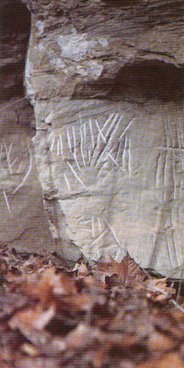
|
Figure H. Photograph of a rebus on the Horse Creek Petroglyph.
Credit: Arnout Hyde, Jr.
|
This is an appropriate point at which to say a little about how the texts are deciphered. When the Ogam strokes are arranged to suggest a picture, the result is what is called a rebus, obviously a device by the scribe to help the reader understand his inscription. The following are the steps by which we can interpret the rebus shown in Figure H.
We note the hand in the lower part of the inscription. In Celtic languages, the
verb stands first in the sentence and is followed by the subject. Accordingly,
we disregard the first few strokes to the left and look for the word "hand"
(lam in Old Irish). As expected, the letters L and M are there. They are preceded
by three upper-case strokes (T), evidently the verb "is" (see Vocabulary
at the end of this article). Thus, in line I-2 we can undertake to separate out
the consonants, as shown. Line I-3 shows the succession of consonants we obtain.
Line I-4 shows the text rewritten with appropriate vowel points inserted, so as
to make a meaningful statement, using all the consonants. The Old Irish, in Latin
script, is given in line I-5. A literal English rendering of each word is given
in line I-6. In line I-7 the words are rearranged to conform to English grammar,
the subject now preceding the verb.

|
Figure J. Rebus with Ogam strokes that are incorporated in a hand.
Credit: Arnout Hyde, Jr.
|
A different type of rebus is shown in Figure J. Here all the Ogam strokes are incorporated into the hand, and there are three transverse stem lines crossing the strokes. This warns us that the Ogam strokes are to be read separately for each of the stem lines, assuming therefore different alphabet values according to whether they stand above, or below, or across, any given stem line. In short, the whole device is a monogram in which various letters have been superimposed. The resulting decipherment (Figure K) yields a sequence of Old Irish words: Atar, Mac, Sbiorad Noib, Oin Dia—"Father, Son and Holy Spirit, One God." And reference to early Christian literatures, such as the writings of Julian of Norwich, or Pier's Plowman, discloses that the mystical meaning of the Dextera Dei is that the hand symbolizes the unified Trinity, the closed fist God the Father, the fingers God the Son and the Palm the Holy Spirit.
THE WYOMING COUNTY PETROGLYPH TRANSLATION

Figure L. Chalked Wyoming County Petroglyph.
Credit: Gerald Ratliff
The photograph shown here (Figure L) was sent to me in mid-November 1982, by Arnout Hyde Jr. at the request of Ida Jane Gallagher, with a request that the inscription depicted be deciphered if possible. On November 22 I telephoned Mrs. Gallagher, giving her my decipherment and asking if it would be possible to have observers at the site on December 22, in order to check whether the events given in the translation do in fact occur.
The December 22nd visit is described in detail in Mrs. Gallagher's article, "Light Dawns on West Virginia History."
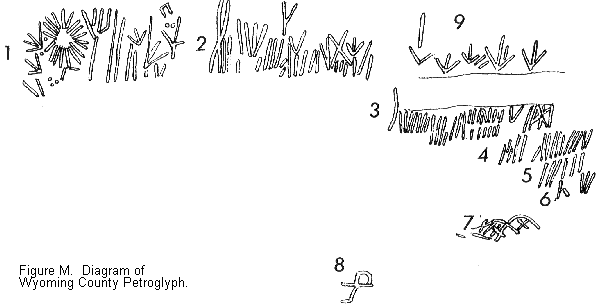
The various sections of the Wyoming County Petroglyph text, as separately deciphered, are numbered on Figure M. Section M-9 is the added Algonquian text, to be discussed in a later article. There is also a Libyan text, some letters of which (appearing as dots in twos and threes, between the Ogam letters) partly overlap the Ogam, but mainly are contained on an adjacent panel not shown here. The Libyan text will be discussed in a later article. Both the Algonquian and Libyan texts appear to be later additions, each making appropriate comment on the Old Irish text.
My translations of lines 1 through 6 of the Wyoming County Petroglyph are given in Figures M-1 through M-6.


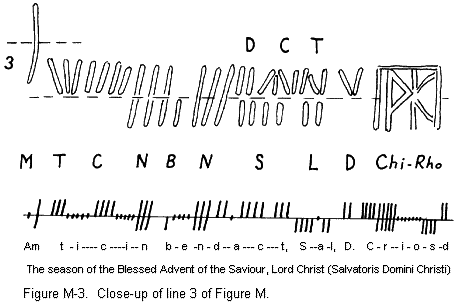
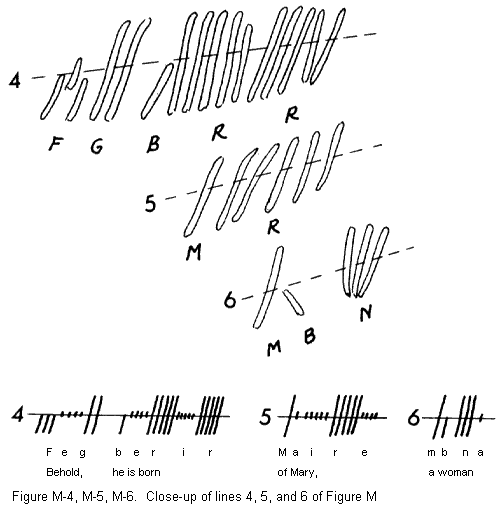
THE HORSE CREEK PETROGLYPH TRANSLATION
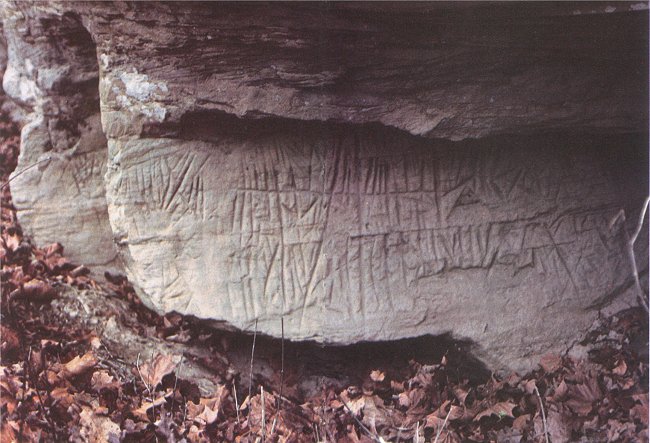
|
Figure N. Photograph of Horse Creek Petroglyph.
Credit: Arnout Hyde, Jr.
|
A three-line Ogam text occurs on a rock face in Boone County, West Virginia, called the Horse Creek Petroglyph (Figure N).
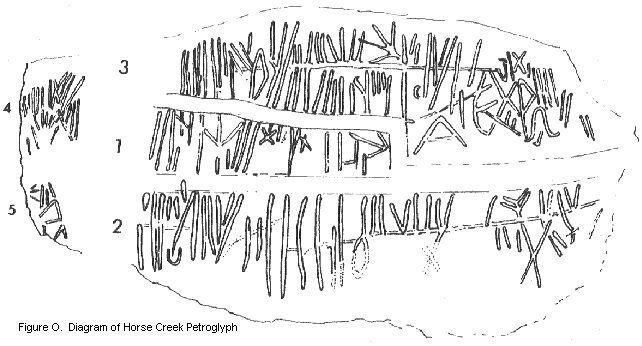
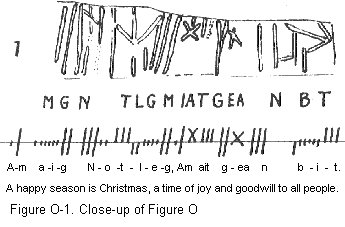
|
The diagram of the Horse Creek Petroglyph (Figure O) gives an exploded layout of the various texts. The two on the left, numbered 4 and 5, have already been referred to under the name "Dextera Dei" or "Right Hand of God." The horizontal lines 1, 2 and 3 comprise the Old Irish text, a short biblical abstract of the second chapter of the Gospel of Luke. The Old Norse three-line rock inscriptions are read in the sequence, first the middle line, next the bottom line, and last the top line. It would seem that this rule applies also here, as the most logical sequence. It would seem that the oldest part of the inscription is the upper right section, with the Chi-Rho, Alpha and Omega. At some later date a scribe decided to cut a Nativity text on the rock in such manner that the culminating event, the actual naming of the Christ Child, would be cited at the point when his text reached the pre-existing sacred signs for the name of Christ. He succeeded, but at a cost of overcrowding his text in the final section, which is consequently difficult to disentangle.
My translation of the Horse Creek Petroglyph is given in Figures O-1, O-2, and O-3.
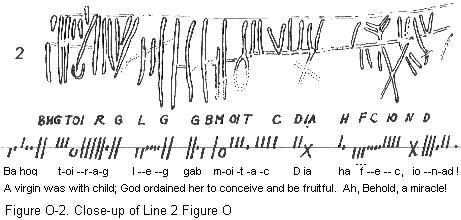
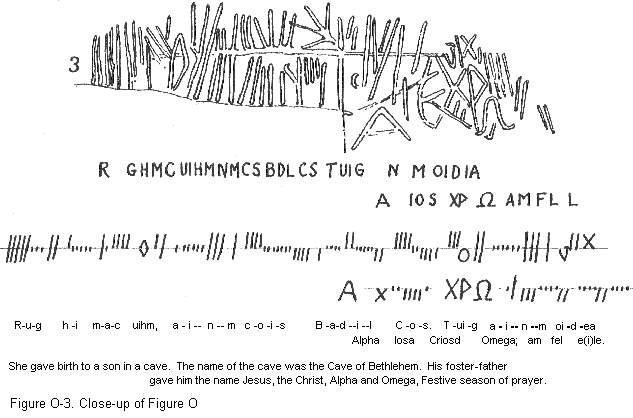
The West Virginia Ogam texts are the longest Ogam inscriptions recorded from anywhere in the world. They exhibit the grammar and vocabulary of Old Irish in a manner previously unknown in such early rock-cut inscriptions in any Celtic language. The protection of these sites is of paramount importance. It has been an inspiring privilege to work with such historic material.
Dr. Barry Fell is an emeritus professor at Harvard University. He came
to America from New Zealand in 1964. In addition to being a world-recognized authority
on marine biology, he is president of the Epigraphic Society, and is editor and
co-author of eight volumes of decipherments of ancient inscriptions. He wrote
America B.C., which the American Booksellers Association presented to
the White House in 1977 as one of the best 250 books published between 1973 and
1977 in the United States.
In his writings, Fell documents extensive and profound evidence, along with numerous photographs and illustrations, which supports his belief that America had ancient European, African and Nordic visitors centuries before Columbus landed on its shores. Wonderful West Virginia readers who wish to learn more about this subject may order the following books by Fell from a bookstore: America B.C. (published by Quadrangle/The New York Times Book Company), Saga America (published by Quadrangle/The New York Times Book Company) and Bronze Age America (published by Little, Brown and Company Boston and Toronto).
VOCABULARY
Early Irish words found engraved on West Virginian rocks:
[Optical character recognition is reasonably accurate, but it is not a perfect way to digitize text. There may be bad characters in this section. -- Webmaster]
Abbreviations: B, Bethlehem Rock site; DD, Dextera Dei inscriptions; SR, Christmas Sunrise site; L, Latin rendered in Ogam letters; G, Greek symbols; adj, adjective; adv, adverb; n, noun; v, verb.
aig (adj) happy, auspicious B
aite (adj) joyful, glad B
am (n) time, season B, SR
ainm (n) name B
atar, atair (n) father DD
Alpha Omega (n) 'He that is first and shall be last" G, B.
ba (v) was, were (from bi, to be) B
ben (n) woman; ossessive case mbna (Irish mna) SR
Bedil (n) Bethlehem B
Bedil Cos (n) The Cave of Bethlehem B
bendact (adj) blessed, L. benedictus SR
berir (v) he is born SR
bi (v) to be B, DD
bit (n) the world, all people B
bliatain (n) year SR
cab (n) notch, hollow SR
cos (n) cave B
Chi-Rha Criosd or Christus, G. symbols used by early Christians B, SR
D (1) abbreviation of L. die, on the day; D. Natal; L, Die Natale, on the day of Christmas, lit. "Birthday" of Christ. SR (2) abbreviation of L. Dominus, Lord, Domini, of the Lord SR
des (adj) right, right-hand DD
di (n) dav SR
Dia (n) God, of God B, DD
dion (n] shield, shelter DD
doisag (adj) first (O. Irish toisech) SR
eaglais (n) church SR
ele (n) prayer DD, BR
erig-gren (a) sunrise SR
fec, feg (v) behold! SR, B
fel, feil (n) feast, Feast Day (of the Church) B, SR
gab (v) conceive B
gad (n) ray, sunbeam (O. Irish gat, a dart) SR
gean (n) good will B
gian (for gain) (n) nativity, the Incarnation (of Christ) SR
gle (adj) left, left hand (O. Irish cle) SR
glet (adj) an the left side SR
grian (n) sun, gren, of the sun SR
hi, i (pronoun) she B
hog (n) virgin, maiden (O. Irish og, oige) B
iongad (n) miracle B
Iosa (n) Jesus B
lam (n) hand DD
Lam Des Dia right hand of God, L. Dextera Dei DD
leg, leig (v) cause, ordain B
mc, mac (n) son; Mac Dia, the Son of God B, DD
mbna (n) of a woman, possessive case of ben; Irish mna SR
moitac (adj) pregnant, (n) pregnant woman; apparently an American usage, in Ireland not used for human beings B
Maire, Muire (a) Mary, of Mary SR
Natal. (adj) L. Natalis, pertaining to a birth; D. Natal., L, Die Natale, on Christmas Day; see Notleg SR
noib (adj) holy, sacred DD
Notleg (n) Christmas, L. Natalica. In later Irish and Gaelic the word became Nollaig, meaning Christmas and (in Ireland) December B
oidia (n) foster father; at B, used for Joseph B
oin, oen (n) one; Oin Dia, One God DD
rug (v) gave birth to B
Sal. (v) L. Salvator, Savior SR
Sbiorad (n) spirit, L. Spiritus DD
Spiorad Noib The Holy Spirit DD
sif (v) to graze, sweep past, Gaelic siabh SR
ta (v) is, are, (ata at the beginning of a sentence) DD
ticin (n) coming, Advent SR
torag (adj) pregnant, with child; Irish torach B
tuig (v) give, gave B
uihm (n) cave, stone chamber or stable (for uaim) B
West Virginia Archeologist:
Hunter Lesser on cult archaeology
West Virginia Archeologist:
Oppenheimer and Wirtz look at Fell's methodology
Wonderful West Virginia: Robert
L. Pyle on pre-Columbian contacts
West Virginia Archeologist:
Hunter Lesser looks for pseudoscience, and finds it
Wonderful West Virginia:
Ida Jane Gallagher finds a "solstice alignment"
West Virginia Archeologist:
Roger Wise looks for that "solstice alignment" again
Wonderful West Virginia:
Barry Fell deciphers Christian messages
A second opinion:
A very different
translation of Horse Creek
West Virginia Archeologist: Janet Brashler looks for all possible explanations,
and tests them




